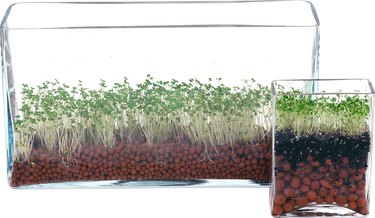
Temperature is one of the main factors affecting plant growth. From the seed germination to flowering, many stages of each plant's life are temperature dependent. Plants vary considerably, however, in their response to temperature. Those from cold winter climates, for instance, have different optimum temperatures for seed germination than plants native to tropical areas.
Effects On Germination
Video of the Day
Seeds will sprout only when the temperature reaches the optimal level for that species. Spinach and other cool-season vegetables germinate best at 55 to 65 degrees Fahrenheit; petunias and tomatoes will wait until the soil warms to 65 to 75 degrees F. Many weeds, however, germinate quite well in cold, spring soil. If you start your seeds indoors, remember that seedlings like slightly cooler conditions after germination, about 10 degrees lower.
Video of the Day
Effects On Growth
Photosynthesis is the process of building carbohydrates and proteins, the food the plant needs to grow. Respiration is the process of using and breaking down these products. Both increase as temperature rises; eventually photosynthesis slows, and respiration becomes dominant. The plant stops growing because it's using up food more quickly than it can be replaced. Low temperatures slow the rate of photosynthesis, also slowing the growth rate. Some plants, however, grow rapidly between 40 and 60 degrees F, while others need higher temperatures to begin growth.
Effects On Flowering
The timing of flowering and fruiting is determined both by day length and by temperature. A Christmas cactus, for instance, needs both short days and lower temperatures to form buds. High temperatures during the long days of summer cause lettuce and spinach to stop producing leaves; they put all their energy into flower formation. Knowing the optimum growing temperatures for your crops will help you time your plantings for greater harvests.
Effects On Hardiness
At lower temperatures, plants reduce their use of carbohydrates as energy and increase their storage as sugars. Along with decreased day length, cooler temperatures induce the changes in plant tissues that will allow them to survive cold weather. The more gradual the adjustment, the less damage a plant will show after a cold spell. A hard, early freeze may be disastrous if the cellular changes haven't been completed.
- North Carolina State University: Temperature Effect on Plants: Erv Evans
- Iowa State University Extension: Successful Seed Germination: Sherry Rindel: Feb. 9, 1996
- Oregon State University Extension: Master Gardener Training: Environmental Factors Affecting Growth: Temperature
- University of Minnesota: Roses for the North: Cold Hardiness